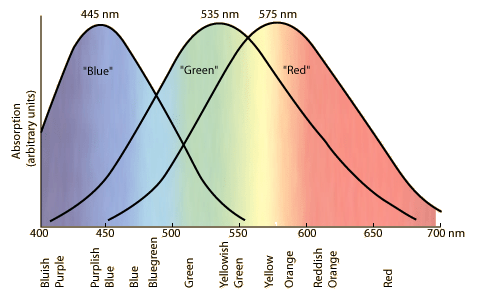Originally posted by Rothrandir:
the primary colord for light are red green and blue, whereas the primary colors for colors are red yellow blue.
right?
<font size="2" face="Verdana, Arial">I think that's only partially right. Our eyes have three types of color sensitive cones, each sensitive to a of range wavelengths.
As you can see from this graph, a yellowish-green wavelength (say around 550nm) stimulates both the red-sensitive and green-sensitive cones about equally. Our eyes would see the same color if you mixed a greener wavelength with a redder wavelength that ended up stimulating those cells in the same proportion.
You can even get a sense here of why it's difficult to make a consistent white LED. Here is Mike from Inretech's measured spectrum of a white Luxeon:
The blue spike comes from the LED itself, and the greenish-yellowish mound comes from the phosphor coating on the LED that is being stimulated by the blue light from the LED. Mix greenish-yellow with blue, and what do you get? A nice hot blue white, if you're lucky. If you're unlucky, you see too much phosphor and you get the famous pee-green effect. Too little, and you see too much blue.
This spectrum is very unlike this incandescent (2100° K) lamp, which has much less blue and much more red.
Hence objects can appear very different under different "white" lights. Light on the left is double-barrel 4-AAA incandescent flashlight. On the right is a 1W white Luxeon.







